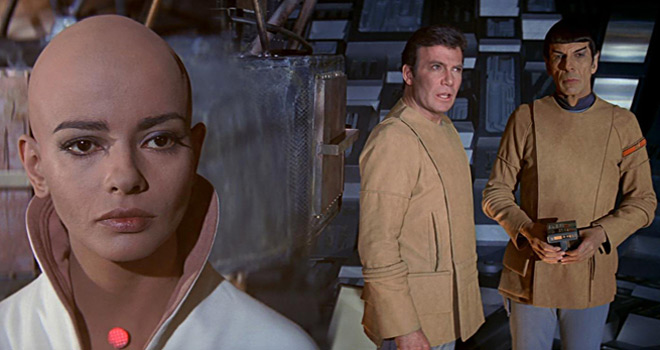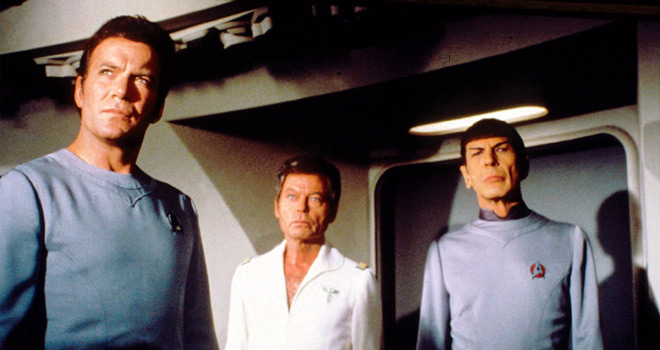Star Trek: The Motion Picture is now 40 years old, having originally been released on December 7, 1979, and it is said some of the original cinemagoers are still in the theaters, waiting for it to end. This is because the film has a reputation for having a lagging pace, with critics at the time calling it “The Slow-Motion Picture.” Aiming to be a smarter brand of Sci-Fi compared to the derring-do of 1977’s Star Wars, while it was a financial success, earning $132 million at the box office, the film did not particularly enlighten audiences.

The movie project began in 1975, where Gene Roddenberry (Have Gun- Will Travel series) and a brace of writers and producers went through idea after idea. They either could not find one ‘big enough’, or when someone did come up with an idea, they ended up getting squeezed out one way or another. The crew could have traveled back in time to save cavemen or faced the Greek Titans, or Spock could have fought a Klingon played by Toshiro Mifune (Yojimbo 1961, Sekigahara 1981). None of these worked out.
So, the film was then cancelled. Shame this happened just a few weeks shy of the release of Star Wars in 1977. Luckily, a script for the attempted Star Trek: Phase II TV series impressed then-Paramount boss Michael Eisner into re-opening the movie project. New Director Robert Wise (West Side Story 1961, The Andromeda Strain 1971) even managed to convince the studio to settle a lawsuit Leonard Nimoy (Invasion of the Body Snatchers 1978, Vincent 1981) filed against them for using his likeness without permission; all so they could make sure the film had Mr. Spock in it.
There was a caveat though: Nimoy would be allowed to tweak the script if need be. The writing process proved chaotic, with credited co-writer Harold Livingston (Mission: Impossible TV series) quitting the project about three times due to conflicts with Roddenberry. By the end of production, script amendments had gotten so common that they could be timed. According to Livingston, “Gene was a great idea man and a good story man, but he just couldn’t execute.” By contrast, he said Nimoy’s edits “enhanced the script considerably.”

There was also trouble with the special effects, with $5 million of the film’s initial $15 million budget spent on unusable footage. The crew ended up gaining Douglas Trumbull (2001: A Space Odyssey 1968, Blade Runner 1982) as their new supervisor of special effects, subsequently doubling the budget. It got to the point where the camera crew had to shoot one end of the mysterious spacecraft V’Ger while it was still being worked on at the other end.
Still, the film managed to come out to that less-than-stellar reception. On paper, the story is promising: an alien entity known as V’Ger slowly approaches Earth and destroys everything in its path. Admiral Kirk (William Shatner: Batman vs. Two-Face 2017) takes command of the refitted USS Enterprise from new captain Willard Decker (Stephen Collins: 7th Heaven series) to examine it and save Earth in the process.
The old guard vs. new guy conflict between Kirk and Decker is a solid, classic standard. Persis Khambatta (Warrior of the Lost World 1983) even does well as the Deltan newcomer Ilia, having shaved her head for the role (and putting insurance on her hair if it did not grow back, which it did). The bald look was striking enough for the poster, and certainly draws the eye. Just a shame her character, and the overall film, does not live up to its promise.
Ilia does not leave much impact dramatically until she encounters V’Ger and becomes its avatar as such. Decker does not really click on screen much either. The film has the ingredients to get audiences to care about him- with him losing control of the Enterprise, and even some backstory lore (Kirk met his father in the original TV series), yet they do not come together. Collins tries, but the character ends up doing little but being there until the film’s flashy climax.

The same goes for much of the old crew. DeForest Kelley (The Littlest Hobo 1981) felt the script lacked the spirit of the old series and fought for more characterization for the cast. Ultimately his suggestions were ignored, as were the objections of Nichelle Nichols (American Nightmares 2018) to the new uniform designs. She felt they were drab and did not fit the characters, much less Uhura. They have certainly dated more than later Federation designs, especially when Kelley’s Dr. McCoy appears, looking less 23rd Century and more Studio 54.
However, the biggest flaw lies in the pacing. The run-time may say it lasts 132 minutes, but the scene of Kirk seeing the new Enterprise feels twice that length alone. Let alone the slow-motion assault on the Enterprise, or the many, flashy V’Ger sequences. The film did receive a director’s cut on VHS and DVD in 2001 that, despite being 4 minutes longer, did amend some of the pacing issues. However, for those preceding years, it did show that Roddenberry and co. were too focused on making the film look big and have big ideas. Instead of being mentally buff, it ended up bloated and lethargic.
It is not all doom and gloom though. The direction is fair, and the presentation is quite strong. The drama’s promise was strong enough to find favor with fans to this day, particularly with its legitimately chilling teleporter malfunction scene (“Enterprise, what we got back didn’t live long…fortunately”). Not to mention it showcases a few famous firsts, like Jerry Goldsmith’s score (which would later become the Star Trek: The Next Generation theme), the new wrinkly-forehead Klingons, and their throat-murdering language.
Star Trek: The Motion Picture manages to be a little more endearing now than 40 years ago. Sure, the issues with pacing, airless characters, etc., are still there, but it has also been improved upon with its sequels, like 1982’s Star Trek II: The Wrath of Khan. Yet its new designs and ideas inspired those better successors (especially TNG), while still remaining a better watch than its worst (e.g. 2002’s Star Trek: Nemesis). Its flaws make it hard to embrace, but for making Star Trek history, it is worth a handshake.






No comment